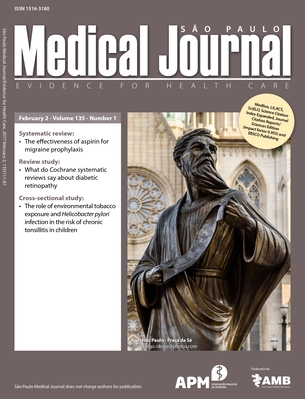Academic performance of students who underwent psychiatric treatment at the students’ mental health service of a Brazilian university
Keywords:
Mental disorder, Counseling, Universities, Students, Mental healthAbstract
CONTEXT AND OBJECTIVE: University students are generally at the typical age of onset of mental disorders that may affect their academic performance. We aimed to characterize the university students attended by psychiatrists at the students’ mental health service (SAPPE) and to compare their academic performance with that of non-patient students. DESIGN AND SETTING: Cross-sectional study based on review of medical files and survey of academic data at a Brazilian public university. METHODS: Files of 1,237 students attended by psychiatrists at SAPPE from 2004 to 2011 were reviewed. Their academic performance coefficient (APC) and status as of July 2015 were compared to those of a control group of 2,579 non-patient students matched by gender, course and year of enrolment. RESULTS: 37% of the patients had had psychiatric treatment and 4.5% had made suicide attempts before being attended at SAPPE. Depression (39.1%) and anxiety disorders/phobias (33.2%) were the most frequent diagnoses. Severe mental disorders such as psychotic disorders (3.7%) and bipolar disorder (1.9%) were less frequent. Compared with non-patients, the mean APC among the undergraduate patients was slightly lower (0.63; standard deviation, SD: 0.26; versus 0.64; ID: 0.28; P = 0.025), but their course completion rates were higher and course abandonment rates were lower. Regarding postgraduate students, patients and non-patients had similar completion rates, but patients had greater incidence of discharge for poor performance and lower dropout rates. CONCLUSION: Despite the inclusion of socially vulnerable people with severe mental disorders, the group of patients had similar academic performance, and in some aspects better, than, that of non-patients.
Downloads
References
O'Connor PJ, Martin B, Weeks CS, Ong L. Factors that influence young people's mental health help-seeking behaviour: a study based on the Health Belief Model. J Adv Nurs. 2014;70(11):2577-87.
Blanco C, Okuda M, Wright C, et al. Mental health of college students and their non-college-attending peers: results from the National Epidemiologic Study on Alcohol and Related Conditions. Arch Gen Psychiatry. 2008;65(12):1429-37.
Facundes VLD, Ludermir AB. Common mental disorders among health care students. Rev Bras Psiquiatr. 2005;27(3):194-200.
Cerchiari EAN. Saúde mental e qualidade de vida em estudantes universitários [thesis]. São Paulo: Universidade Estadual de Campinas; 2004.
Universidade Estadual de Campinas. História: Jovem, mas com tradição. Available from: http://www.unicamp.br/unicamp/a-unicamp/historia Accessed in 2016 (Oct 14).
Assessoria de Economia e Planejamento - AEPLAN. Anuário estatístico 2012. Base 2011. Universidade Estadual de Campinas, 2004. Available from: http://www.aeplan.unicamp.br/anuario/2012/anuario2012.pdf Accessed in 2016 (Oct 14).
Universidade Estadual de Campinas. Serviço de Apoio Psicológico e Psiquiátrico ao Estudante (SAPPE). Available from: http://sappe.basico.unicamp.br/sappe/ Accessed in 2016 (Oct 14).
Oliveira ML, Dantas Cde R, Azevedo RC, Banzato CE. Demographics and complaints of university students who sought help at a campus mental health service between 1987 and 2004. Sao Paulo Med J. 2008;126(1):58-62.
Dantas Cde R, Santos Júnior AD, Oliveira ML, Azevedo RC, Banzato CE. Brazilian university students: predictors of seeking mental health care for a second time. Sao Paulo Med J. 2011;129(3):181-2.
Comissão Permanente de Vestibulares (Comvest). Progrma de isenção da taxa de inscrição. Vestibular Unicamp. Available from: https://www.comvest.unicamp.br/isencao/numeros.html Accessed in 2016 (Oct 21).
Conover WJ. Practical nonparametric statistics. 3rd ed. New York: John Wiley & Sons Inc.; 1999.
Fleiss JL. Statistical methods for rates and proportions. 2nd ed. New York: John Wiley & Sons Inc.; 1981.
Gama CAP, Campos RTO, Ferrer AL. Saúde mental e vulnerabilidade social: a direção do tratamento [Mental health and social vulnerability: direction of the treatment]. Rev Latinoam Psicopatol Fundam. 2014;17(1):69-84.
Santos EG, Siqueira MM. Prevalência dos transtornos mentais na população adulta brasileira: uma revisão sistemática de 1997 a 2009 [Prevalence of mental disorders in the Brazilian adult population: a systematic review from 1997 to 2009]. J Bras Psiquiatr. 2010;59(3):238-46.
Bailer J, Schwarz D, Witthöft M, Stübinger C, Rist F. [Prevalence of mental disorders among college students at a German university]. Psychother Psychosom Med Psychol. 2008;58(11):423-29.
Viana MC, Andrade LH. Prevalência em toda a vida, distribuição por idade e sexo e idade de início de transtornos psiquiátricos na área metropolitana de São Paulo, Brasil: resultados do Estudo Epidemiológico de Transtornos Mentais São Paulo Megacity [Lifetime Prevalence, age and gender distribution and age-of-onset of psychiatric disorders in the São Paulo Metropolitan Area, Brazil: results from the São Paulo Megacity Mental Health Survey]. Rev Bras Psiquiatr. 2012;34(3):249-60.
Macaskill A. The mental health of university students in the United Kingdom. British Journal of Guidance and Counselling. 2012;41(4):426-41. Available from: http://shura.shu.ac.uk/6449/1/Macaskill_University_students.pdf Accessed in 2016 (Oct 14).
White HR, Labouvie EW, Papadaratsakis V. Changes in substance use during the transition to adulthood: A comparison of college students and their noncollege age peers. Journal of Drug Issues. 2005;35(2): 281-306. Available from: http://jod.sagepub.com/content/35/2/281.abstract Accessed in 2016 (Oct 14).
Hunt J, Eisenbeg D, Kilbourne AM. Consequences of receipt of a psychiatric diagnosis for completion of college. Psychiatr Serv. 2010;61(4):399-404.






